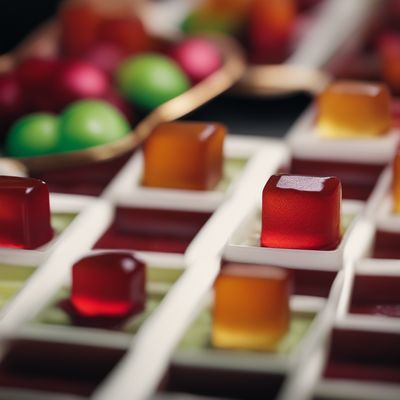
Recipe
Hanetsuki Mochi - Traditional Japanese New Year's Treat
Fluffy Delights: Hanetsuki Mochi - A Sweet Celebration of Japanese New Year
3.8 out of 5
Hanetsuki Mochi is a beloved traditional Japanese treat that is commonly enjoyed during the New Year's festivities. This delightful dish consists of soft and chewy mochi cakes, delicately flavored with sweet red bean paste and dusted with fragrant kinako powder. It is a symbol of good luck and prosperity for the coming year.
Metadata
Preparation time
30 minutes
Cooking time
20 minutes
Total time
50 minutes
Yields
12 servings
Preparation difficulty
Medium
Suitable for
Vegetarian, Vegan (if using vegan sweet red bean paste), Gluten-free (if using gluten-free glutinous rice flour), Nut-free, Dairy-free
Allergens
N/A
Not suitable for
Paleo, Keto, Low-carb, High-protein, Low-fat
Ingredients
-
2 cups (240g) glutinous rice flour 2 cups (240g) glutinous rice flour
-
1 1/4 cups (295ml) water 1 1/4 cups (295ml) water
-
1 cup (230g) sweet red bean paste 1 cup (230g) sweet red bean paste
-
1/4 cup (30g) kinako powder 1/4 cup (30g) kinako powder
-
Cornstarch, for dusting Cornstarch, for dusting
Nutrition
- Calories (kcal / KJ): 150 kcal / 628 KJ
- Fat (total, saturated): 1g, 0g
- Carbohydrates (total, sugars): 35g, 10g
- Protein: 2g
- Fiber: 1g
- Salt: 0g
Preparation
-
1.In a large bowl, combine the glutinous rice flour and water. Mix well until a smooth and sticky dough forms.
-
2.Transfer the dough to a heatproof dish and steam over high heat for 20 minutes, or until the dough becomes translucent.
-
3.Dust a clean surface with cornstarch to prevent sticking. Carefully transfer the steamed dough onto the surface.
-
4.Divide the dough into small portions and flatten each portion into a round disc.
-
5.Place a spoonful of sweet red bean paste in the center of each disc. Fold the edges of the dough over the filling and pinch to seal.
-
6.Roll each filled mochi cake in kinako powder until fully coated.
-
7.Serve the Hanetsuki Mochi immediately or store in an airtight container for up to 2 days.
Treat your ingredients with care...
- Glutinous rice flour — Make sure to use glutinous rice flour specifically made for mochi, as regular rice flour will not yield the desired texture.
- Sweet red bean paste — If you prefer a sweeter filling, you can add a bit of sugar to the red bean paste while cooking it.
Tips & Tricks
- To prevent the mochi dough from sticking to your hands, lightly wet your hands with water or oil before handling.
- If kinako powder is not available, you can substitute it with finely ground roasted peanuts or sesame seeds.
- For an extra touch of sweetness, you can drizzle honey or maple syrup over the Hanetsuki Mochi before serving.
- To enhance the flavor, lightly toast the kinako powder in a dry pan before using it.
- If you prefer a smoother texture, you can strain the sweet red bean paste before using it as a filling.
Serving advice
Serve the Hanetsuki Mochi on a beautiful platter or individual plates. Garnish with a sprinkle of kinako powder and a few red bean paste swirls for an elegant presentation. Enjoy them with a cup of hot green tea for a truly authentic experience.
Presentation advice
Arrange the Hanetsuki Mochi in a circular pattern on a traditional Japanese lacquerware tray or a wooden serving board. Place a small dish of kinako powder in the center for dipping. Add a few fresh mint leaves or edible flowers as a decorative touch.
More recipes...
For Hanetsuki
More Japanese cuisine dishes » Browse all

Uramaki
Inside-out roll
Uramaki is a type of sushi that is made with rice, seaweed, and a variety of fillings. It is a popular dish in Japanese cuisine, and is often...

Neri yokan
Neri yokan is a traditional Japanese sweet that is made from adzuki beans, sugar, and agar. It is a soft, jelly-like candy that is often flavored...

Negima yakitori
Scallion and Chicken Yakitori
Negima yakitori is a traditional Japanese dish that is typically served as a snack or appetizer. It is a flavorful and aromatic dish that is sure...





